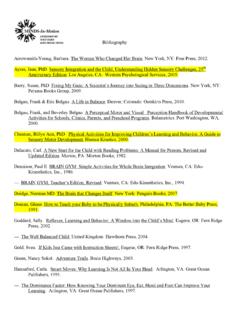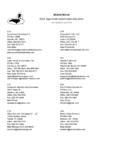Transcription of The Thirty Million Word Gap - A Summary
1 The Thirty Million Word Gap A Summary from "The Early catastrophe : The 30 Million Word Gap by Age 3" by University of Kansas researchers Betty Hart and Todd R. Risley. (2003). American Educator. Spring: 4-9, which was exerpted with permission from B. Hart and Risley (1995). Meaningful Differences in the Everyday Experiences of Young American Children. Baltimore, MD: Brookes Publishing. In this groundbreaking study, University of Kansas researchers Betty Hart and Todd Risley entered the homes of 42 families from various socio-economic backgrounds to assess the ways in which daily exchanges between a parent and child shape language and vocabulary development.
2 Their findings were unprecedented, with extraordinary disparities between the sheer number of words spoken as well as the types of messages conveyed. After four years these differences in parent-child interactions produced significant discrepancies in not only children s knowledge, but also their skills and experiences with children from high-income families being exposed to 30 Million more words than children from families on welfare. Follow-up studies showed that these differences in language and interaction experiences have lasting effects on a child s performance later in life.
3 The Early catastrophe Betty Hart & Todd R. Risley Mission: Betty Hart and Todd Risley were at the forefront of educational research during the 1960 s War on Poverty. Frustrated after seeing the effects of their high quality early intervention program aimed at language skill expansion prove unsuccessful in the long-term, they decided to shift their focus. If the proper measures were being taken in the classroom, the only logical conclusion was to take a deeper look at the home. What difference does home-life make in a child s ability to communicate?
4 Why are the alarming vocabulary gaps between high school students from low and high income environments seemingly foreshadowed by their performance in preschool? Hart and Risley believed that the home housed some of these answers. Experimental Method: Hart and Risley recruited 42 families to participate in the study including 13 high-income families, 10 families of middle socio-economic status, 13 of low socio-economic status, and 6 families who were on welfare. Monthly hour-long observations of each family were conducted from the time the child was seven months until age three.
5 Gender and race were also balanced within the sample. Results: The results of the study were far more severe than anyone could have anticipated. Observers found that 86% to 98% of the words used by each child by the age of three were derived from their parents vocabularies. Furthermore, not only were the words they used nearly identical, but also the average number of words utilized, the duration of their conversations, and the speech patterns were all strikingly similar to those of their caregivers. After establishing these patterns of learning through imitation, the researchers next analyzed the content of each The number of words addressed to children differs across income to garner a better understanding of each child s experience.
6 They found that the sheer number of words heard varied greatly along socio-economic lines. On average, children from families on welfare were provided half as much experience as children from working class families, and less than a third of the experience given to children from high-income families. In other words , children from families on welfare heard about 616 words per hour, while those from working class families heard around 1,251 words per hour, and those from professional families heard roughly 2,153 words per hour. Thus, children from better financial circumstances had far more language exposure to draw from.
7 In addition to looking at the number of words exchanged, the researchers also looked at what was being said within these conversations. What they found was that higher-income families provided their children with far more words of praise compared to children from low-income families. Children's vocabulary differs greatly across income , children from low-income families were found to endure far more instances of negative reinforcement compared to their peers from higher-income families. Children from families with professional backgrounds experienced a ratio of six encouragements for every discouragement.
8 For children from working-class families this ratio was two encouragements to one discouragement. Finally, children from families on welfare received on average two discouragements for every encouragement. To ensure that these findings had long-term implications, 29 of the 42 families were recruited for a follow-up study when the children were in third grade. Researchers found that measures of accomplishment at age three were highly indicative of performance at the ages of nine and ten on various vocabulary, language development, and reading comprehension measures.
9 Thus, the foundation built at age three had a great bearing on their progress many years to come. Inferences: Within a child s early life the caregiver is responsible for most, if not all, social simulation and consequently language and communication development. As a result, how parents interact with their children is of great consequence given it lays a critical foundation impacting the way the children process future information many years down the road. This study displays a clear correlation between the conversation styles of parents and the resulting speech of their children.
10 This connection evidences just how problematic the results of this study may truly be. The finding that children living in poverty hear fewer than a third of the words heard by children from higher-income families has significant implications in the long run. When extrapolated to the words heard by a child within the first four years of their life these results reveal a 30 Million word difference. That is, a child from a high-income family will experience 30 Million more words within the first four years of life than a child from a low-income family.













![[PUBLISH] IN THE UNITED STATES COURT OF APPEALS FOR …](/cache/preview/0/7/3/4/8/4/4/6/thumb-07348446070f9a9adbdc796d3164ec9c.jpg)


